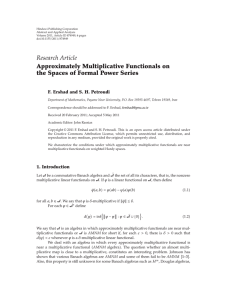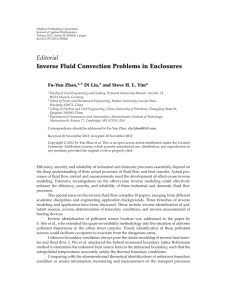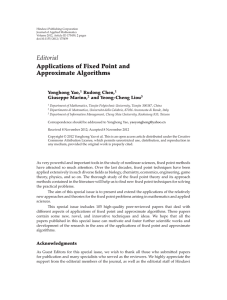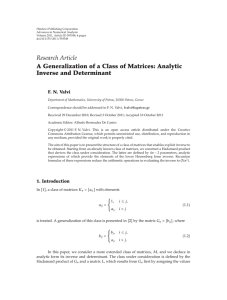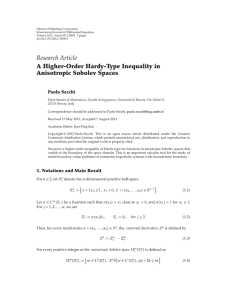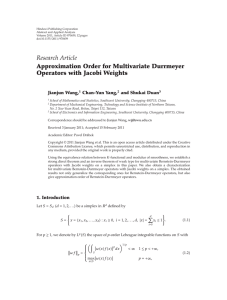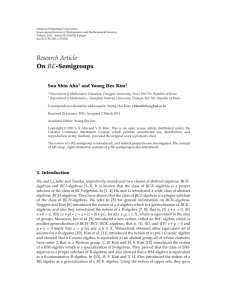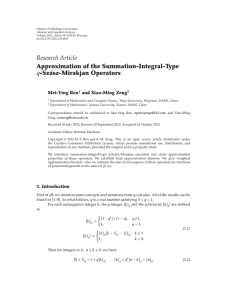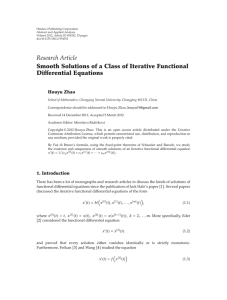Document 10452236
advertisement
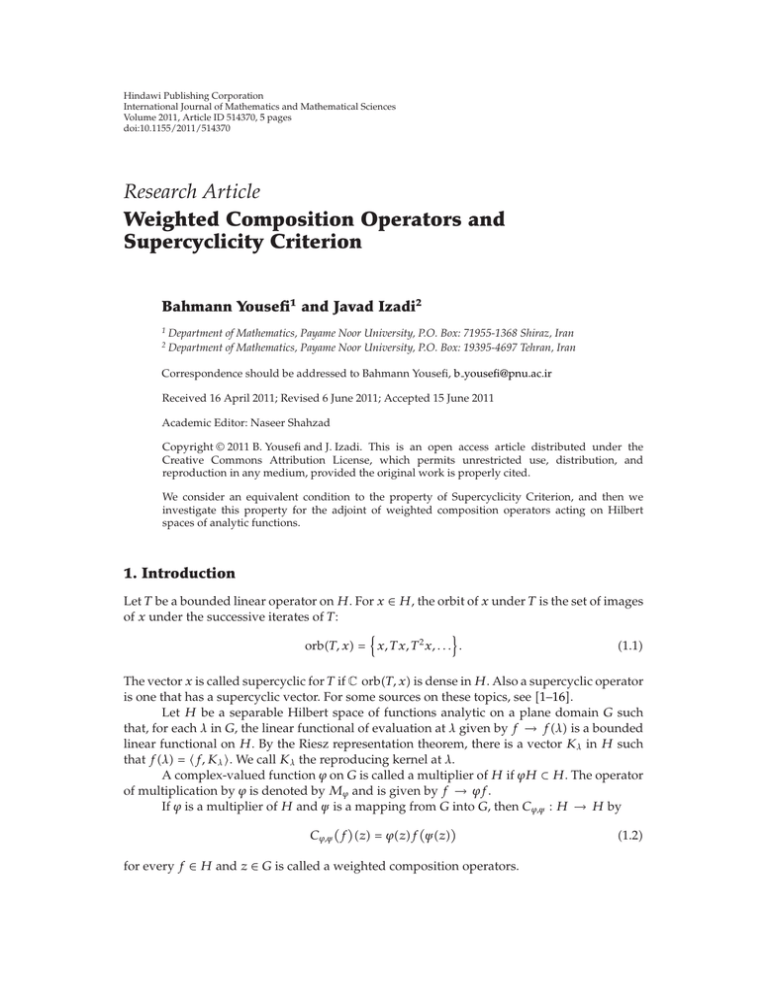
Hindawi Publishing Corporation
International Journal of Mathematics and Mathematical Sciences
Volume 2011, Article ID 514370, 5 pages
doi:10.1155/2011/514370
Research Article
Weighted Composition Operators and
Supercyclicity Criterion
Bahmann Yousefi1 and Javad Izadi2
1
2
Department of Mathematics, Payame Noor University, P.O. Box: 71955-1368 Shiraz, Iran
Department of Mathematics, Payame Noor University, P.O. Box: 19395-4697 Tehran, Iran
Correspondence should be addressed to Bahmann Yousefi, b yousefi@pnu.ac.ir
Received 16 April 2011; Revised 6 June 2011; Accepted 15 June 2011
Academic Editor: Naseer Shahzad
Copyright q 2011 B. Yousefi and J. Izadi. This is an open access article distributed under the
Creative Commons Attribution License, which permits unrestricted use, distribution, and
reproduction in any medium, provided the original work is properly cited.
We consider an equivalent condition to the property of Supercyclicity Criterion, and then we
investigate this property for the adjoint of weighted composition operators acting on Hilbert
spaces of analytic functions.
1. Introduction
Let T be a bounded linear operator on H. For x ∈ H, the orbit of x under T is the set of images
of x under the successive iterates of T :
1.1
orbT, x x, T x, T 2 x, . . . .
The vector x is called supercyclic for T if C orbT, x is dense in H. Also a supercyclic operator
is one that has a supercyclic vector. For some sources on these topics, see 1–16.
Let H be a separable Hilbert space of functions analytic on a plane domain G such
that, for each λ in G, the linear functional of evaluation at λ given by f → fλ is a bounded
linear functional on H. By the Riesz representation theorem, there is a vector Kλ in H such
that fλ f, Kλ . We call Kλ the reproducing kernel at λ.
A complex-valued function ϕ on G is called a multiplier of H if ϕH ⊂ H. The operator
of multiplication by ϕ is denoted by Mϕ and is given by f → ϕf.
If ϕ is a multiplier of H and ψ is a mapping from G into G, then Cϕ,ψ : H → H by
Cϕ,ψ f z ϕzf ψz
for every f ∈ H and z ∈ G is called a weighted composition operators.
1.2
2
International Journal of Mathematics and Mathematical Sciences
The holomorphic self-maps of the open unit disk D are divided into classes of elliptic
and nonelliptic. The elliptic type is an automorphism and has a fixed point in D. It is well
known that this map is conjugate to a rotation z → λz for some complex number λ with
|λ| 1. The maps of those which are not elliptic are called of non-elliptic type. The iterate of
a non-elliptic map can be characterized by the Denjoy-Wolff Iteration theorem.
2. Main Results
We will investigate the property of Hypercyclicity Criterion for a linear operator and in the
special case, we will give sufficient conditions for the adjoint of a weighted composition
operator associated with elliptic composition function which satisfies the Supercyclicity
Criterion.
Theorem 2.1 Supercyclicity Criterion. Let H be a separable Hilbert space and T is a continuous
linear mapping on H. Suppose that there exist two dense subsets Y and Z in H, a sequence {nk } of
positive integers, and also there exist mappings Snk : Z → H such that
1 T nk Snk z → z for every z ∈ Z,
2 ||T nk y||||Snk z|| → 0 for every y ∈ Y and every z ∈ Z.
Then, T is supercyclic.
If an operator T holds in the assumptions of Theorem 2.1, then one says that T satisfies
the Supercyclicity Criterion.
Definition 2.2. Let T be a bounded linear operator on a Hilbert space H. We refer to
n
n≥1 KerT as the generalized kernel of T .
Theorem 2.3. Let T be a bounded linear operator on a separable Hilbert space H with dense
generalized kernel. Then, the following conditions are equivalent:
1 T has a dense range,
2 T is supercyclic,
3 T satisfies the Supercyclicity Criterion.
Proof. See 2, Corollary 3.3.
Remark 2.4. In 2, for the proof of implication 1 → 3 of Theorem 2.3, it has been shown
that T T is supercyclic which implies by using Lemma 3.1 in 2 that T satisfies the
Supercyclicity Criterion. This implication can be proved directly without using Lemma 3.1
in 2, as follows: If T is a bounded linear operator on a separable Hilbert space H with dense
range and dense generalized kernel, then it follows that T is supercyclic 1, Exercise 1.3. Now
suppose that h0 is a supercyclic vector of T . Set X0 C orbT, h0 and Y0 the generalized
kernel of T . Since T is supercyclic, there exist sequences {nj }j ⊂ N, {αj }j ⊂ C and {fj }j ⊂ H
such that fj → 0 and αj T nj fj → h0 . Define Snk : X0 → H by
Snk αT m h0 ααk T m fk .
2.1
International Journal of Mathematics and Mathematical Sciences
3
Then, clearly, T nk Snk → IX0 pointwise on X0 and
n T k ySn x −→ 0
k
2.2
for every y ∈ Y0 and every x ∈ X0 . Hence, T satisfies the Supercyclicity Criterion.
From now on let H be a Hilbert space of analytic functions on the open unit disc D
such that H contains constants and the functional of evaluation at λ is bounded for all λ in
D. Also let ϕ : D → C be a nonconstant multiplier of H and let ψ be an analytic map from
D into D such that the composition operator Cψ is bounded on H. We define the iterates
ψn ψ ◦ ψ ◦ · · · ◦ ψ n times. By ψn−1 or ψ−n we mean the nth iterate of ψ −1 , hence ψnm ψmn
for m −1, 1.
Definition 2.5. We say that {zn }n≥0 is a B-sequence for ψ if ψzk zk−1 for all k ≥ 1.
Corollary 2.6. Suppose that {zn }n≥0 ⊂ D is a B -sequence for ψ and has limit point in D. If ϕz0 0,
∗
satisfies the Supercyclicity Criterion.
then Cϕ,ψ
Proof. Put A Cϕ,ψ . Since ϕz0 0, we get Kzi ∈ Ker A∗ n for all i 0, ..., n − 1. Hence A∗ has
dense generalized kernel. Now let f, A∗ Kzn 0 for all n, thus ϕzn · f ◦ ψzn 0 for all
n. This implies that f is the zero constant function, because ϕ is nonconstant and {zn }n≥0 has
limit point in D . Thus, A∗ has dense range and, by Theorem 2.3, the proof is complete.
√
√
Example 2.7. Let ψz e− 2πi z, ϕz z − 1/2, and define zn 1/2e 2nπi for all n ≥ 0.
∗
satisfies the Supercyclicity Criterion.
Now by Corollary 2.6, the operator Cϕ,ψ
Theorem 2.8. Let ψ be an elliptic automorphism with interior fixed point p and ϕ : D → C satisfies
∗
the inequality |ϕp| < 1 ≤ |ϕz| for all z in a neighborhood of the unit circle. Then, the operator Cϕ,ψ
satisfies the Supercyclicity Criterion.
Proof. Put Ψ αp ◦ ψ ◦ αp and Φ ϕ ◦ αp where
αp z p−z
.
1 − pz
2.3
Since Ψ is an automorphism with Ψ0 0, thus Ψ is a rotation z → eiθ z for some θ ∈ 0, 2π
∗
∗
and S Cϕ,ψ
. Then, clearly S∗ Cαp T ∗ Cα−1p , thus T is similar
and every z ∈ U. Set T CΦ,Ψ
to S which implies that S satisfies the Supercyclicity Criterion if and only if T satisfies the
Supercyclicity Criterion. Since |αp z| → 1− when |z| → 1− , so |Φ0| < 1 ≤ |Φz| for all
z in a neighborhood of the unit circle. So, without loss of generality, we suppose that ψ is
a rotation z → eiθ z and |ϕ0| < 1 ≤ |ϕz| for all z in a neighborhood of the unit circle.
Therefore, there exist a constant λ and a positive number δ < 1 such that |ϕz| < λ < 1 when
|z| < δ, and |ϕz| ≥ 1 when |z| > 1 − δ. Set U1 {z : |z| < δ} and U2 {z : |z| > 1 − δ}. Also,
consider the sets
H1 span{Kz : z ∈ U1 },
H2 span{Kz : z ∈ U2 },
2.4
4
International Journal of Mathematics and Mathematical Sciences
where span {·} is the set of finite linear combinations of {·}. By using the Hahn-Banach
theorem, H1 and H2 are dense subsets of H. Since ψ is a rotation, the sequence {ψnm λ}n
is a subset of the compact set {z : |z| λ} for each λ in D and m −1, 1. Now by, using the
Banach-Steinhaus theorem, the sequence {Kψnm λ }n is bounded for each λ in D and m −1, 1.
Note that, for each Z, |z| |ψn z|. So, if z ∈ U1 , then |ϕψi z| < λ < 1 and if z ∈ U2 , then
|ϕψi−1 z| ≥ 1 for each positive integer i. Also, note that
n−1
ϕ ψi z Kψn z
S Kz n
2.5
i0
for every positive integer n and z ∈ D see 12. Now, if z ∈ U1 , then Sn Kz → 0 as n → ∞.
Therefore the sequence {Sn } converges pointwise to zero on the dense subset H1 . Define a
sequence of linear maps Wn : H2 → H2 by extending the definition
n
−1
−1
Kψn−1 z
Wn Kz ϕ ψi z
2.6
i1
z ∈ U2 linearly to H2 . Note that, for all z ∈ U2 , the sequence {Wn Kz }n is bounded and
Sn Wn Kz Kz on H2 which implies that Sn Wn is identity on the dense subset H2 . Hence,
n S f Wn g −→ 0
2.7
for every f ∈ H1 and every g ∈ H2 . Now, by Theorem 2.1, the proof is complete.
∗
Corollary 2.9. Under the conditions of Theorem 2.8, Cϕ,ψ
∗
Cϕ,ψ
is supercyclic.
∗
Proof. It is clear since Cϕ,ψ
satisfies the Supercyclicity Criterion.
∗
Example 2.10. Let ϕz 3/2z and ψz eiθ z. Then, the operator Cϕ,ψ
satisfies the
Supercyclicity Criterion, because 0 is an interior fixed point of ψ, and ϕ0 < 1 ≤ |ϕz| for
|z| > 2/3.
References
1 F. Bayart and E. Matheron, Dynamics of Linear Operators, vol. 179 of Cambridge Tracts in Mathematics,
Cambridge University Press, Cambridge, UK, 2009.
2 T. Bermúdez, A. Bonilla, and A. Peris, “On hypercyclicity and supercyclicity criteria,” Bulletin of the
Australian Mathematical Society, vol. 70, no. 1, pp. 45–54, 2004.
3 R. M. Gethner and J. H. Shapiro, “Universal vectors for operators on spaces of holomorphic
functions,” Proceedings of the American Mathematical Society, vol. 100, no. 2, pp. 281–288, 1987.
4 G. Godefroy and J. H. Shapiro, “Operators with dense, invariant, cyclic vector manifolds,” Journal of
Functional Analysis, vol. 98, no. 2, pp. 229–269, 1991.
5 K.-G. Große-Erdmann, “Holomorphe Monster und universelle Funktionen,” Mitteilungen aus dem
Mathematischen Seminar Giessen, no. 176, pp. 1–84, 1987.
6 D. A. Herrero, “Limits of hypercyclic and supercyclic operators,” Journal of Functional Analysis, vol.
99, no. 1, pp. 179–190, 1991.
7 H. N. Salas, “Supercyclicity and weighted shifts,” Studia Mathematica, vol. 135, no. 1, pp. 55–75, 1999.
8 S. Yarmahmoodi, K. Hedayatian, and B. Yousefi, “Supercyclicity and hypercyclicity of an isometry
plus a nilpotent,” Abstract and Applied Analysis, vol. 2011, Article ID 686832, 11 pages, 2011.
International Journal of Mathematics and Mathematical Sciences
5
9 B. Yousefi and H. Rezaei, “Some necessary and sufficient conditions for hypercyclicity criterion,”
Proceedings of the Indian Academy of Sciences, vol. 115, no. 2, pp. 209–216, 2005.
10 B. Yousefi and A. Farrokhinia, “On the hereditarily hypercyclic operators,” Journal of the Korean
Mathematical Society, vol. 43, no. 6, pp. 1219–1229, 2006.
11 B. Yousefi, H. Rezaei, and J. Doroodgar, “Supercyclicity in the operator algebra using Hilbert-Schmidt
operators,” Rendiconti del Circolo Matematico di Palermo II, vol. 56, no. 1, pp. 33–42, 2007.
12 B. Yousefi and H. Rezaei, “Hypercyclic property of weighted composition operators,” Proceedings of
the American Mathematical Society, vol. 135, no. 10, pp. 3263–3271, 2007.
13 B. Yousefi and S. Haghkhah, “Hypercyclicity of special operators on Hilbert function spaces,”
Czechoslovak Mathematical Journal, vol. 57132, no. 3, pp. 1035–1041, 2007.
14 B. Yousefi and H. Rezaei, “On the supercyclicity and hypercyclicity of the operator algebra,” Acta
Mathematica Sinica, vol. 24, no. 7, pp. 1221–1232, 2008.
15 B. Yousefi and R. Soltani, “Hypercyclicity of the adjoint of weighted composition operators,”
Proceedings of the Indian Academy of Sciences, vol. 119, no. 4, pp. 513–519, 2009.
16 B. Yousefi, “Hereditarily transitive tuples,” to appear in Rendiconti del Circolo Matematico di Palermo.
Advances in
Operations Research
Hindawi Publishing Corporation
http://www.hindawi.com
Volume 2014
Advances in
Decision Sciences
Hindawi Publishing Corporation
http://www.hindawi.com
Volume 2014
Mathematical Problems
in Engineering
Hindawi Publishing Corporation
http://www.hindawi.com
Volume 2014
Journal of
Algebra
Hindawi Publishing Corporation
http://www.hindawi.com
Probability and Statistics
Volume 2014
The Scientific
World Journal
Hindawi Publishing Corporation
http://www.hindawi.com
Hindawi Publishing Corporation
http://www.hindawi.com
Volume 2014
International Journal of
Differential Equations
Hindawi Publishing Corporation
http://www.hindawi.com
Volume 2014
Volume 2014
Submit your manuscripts at
http://www.hindawi.com
International Journal of
Advances in
Combinatorics
Hindawi Publishing Corporation
http://www.hindawi.com
Mathematical Physics
Hindawi Publishing Corporation
http://www.hindawi.com
Volume 2014
Journal of
Complex Analysis
Hindawi Publishing Corporation
http://www.hindawi.com
Volume 2014
International
Journal of
Mathematics and
Mathematical
Sciences
Journal of
Hindawi Publishing Corporation
http://www.hindawi.com
Stochastic Analysis
Abstract and
Applied Analysis
Hindawi Publishing Corporation
http://www.hindawi.com
Hindawi Publishing Corporation
http://www.hindawi.com
International Journal of
Mathematics
Volume 2014
Volume 2014
Discrete Dynamics in
Nature and Society
Volume 2014
Volume 2014
Journal of
Journal of
Discrete Mathematics
Journal of
Volume 2014
Hindawi Publishing Corporation
http://www.hindawi.com
Applied Mathematics
Journal of
Function Spaces
Hindawi Publishing Corporation
http://www.hindawi.com
Volume 2014
Hindawi Publishing Corporation
http://www.hindawi.com
Volume 2014
Hindawi Publishing Corporation
http://www.hindawi.com
Volume 2014
Optimization
Hindawi Publishing Corporation
http://www.hindawi.com
Volume 2014
Hindawi Publishing Corporation
http://www.hindawi.com
Volume 2014
